“……He left to make a new start. To eek out a new existence and new lifestyle. To survive. I have always wondered not only why he would leave, but if he had ever looked back. And standing here listening to Cornelia, I believe I have my answer. He left because he had to, but Australia was good for him. He met his wife, had a large family and developed a farm of sizable acreage. He lived to an old age. But Great Grandfather Gasper would have to have left part of his heart in Bosco Gurin I find myself thinking, and I suddenly realise I have done also. For this place feels suprisingly like home. …..”
Day One – 15th. September – Thursday – A big week – Reminder to self, don’t work seven full days and every evening immediately prior to going on holiday but it’s been like that for the last two months, full time at work and personal projects demanding a fair slice of my attention. Getting dad’s memoirs written up (my father passed away in December 2014) and indeed doing them justice with quality image reproduction and interesting layout formats was time consuming. Necessary though as I am taking a copy with me on this adventure, a copy to leave in Switzerland so that part of him can remain with his forefathers in the land so removed from our own shores. I am making the journey my father never made, a pilgrimage to Bosco Gurin in Switzerland, the village my Great Grandfather Gasper Giovanni Tomamichel last saw in 1858.
I departed Tullamarine, Melbourne at 14:20 (2:20 pm) EST and it was a nine hour flight to Hong Kong; a novelty leaving at a reasonable hour. I am flying with Cathay Pacific for this first part of the journey that will eventually take me completely around the globe. I have thirteen flights ahead of me and this first one is reasonably comfortable. But I recall how wearying a long flight can be if you don’t sleep, so I plan to remedy that on the Hong Kong to Zurich leg. I watch a movie then chat for an hour to the Melbourne based mathematics student who is sitting next to me, and time passes quickly. I read and I doze.
Hong Kong airport was easy to negotiate and the gate I needed to leave from was only a short distance from the gate I had entered upon arrival. This next leg from Hong Kong to Zurich is twelve hours. The Cathay Pacific staff are great, however my neighbour in the seat next to me is an older man with not a lot of manners. I was sleeping well, amazing what red wine with supper and exhaustion can achieve but he likes to wake me regularly to get me to move so he can go to the bathroom. I am very fearful the twelve hour flight will be twelve hours of no sleep.
Day Two – 16th. September – Friday – We touchdown at the Zurich airport, Switzerland at 6:26 am. No free wifi at the airport so I can’t notify anyone at home that I arrived safely yet. Sandra, my sister, is due in around 11:30 am, arriving from Rome, but I know she will take almost an hour to get through to customs and collect her bags. I’m keen to smell the air in Switzerland, so I head for the exit doors out of the arrivals terminal that leads to the access walkway across the street. As I step into the open air I breathe in. Deeply. And I am hoping for something remarkable. The first thing my brain registers though is “Yes I am in Europe”. The thick smell of cigarettes has soured the air nearest the doors. Australia has a preoccupation with anti smoking. Europe, frankly, doesn’t give a damn. I am disappointed but nonetheless amused.
I wander around the airport and visit the observation deck. It’s hard to be a photographer of calibre when you have to resort to using your iPhone in places of high security. But I don’t want to be arrested. So I refrain from using the Nikon. Zurich Airport is a maze, but not huge. And certainly not as big as Tullamarine. I go across to the shops and restaurant area across the street from the Arrivals Terminals and again, instantly I’m back in Europe, the pedestrians walk the same way they drive, the foot traffic moving in the direction I am walking is to the right, whilst the oncoming foot traffic is on my left. I smile. It’s wonderful to be back.
I find a boutique coffee and pastry cafe and order a sweet custard raspberry tart, with a raspberry coulis sauce and cappuccino. Delicious. Europeans certainly know how to make exquisite pastries. It’s light, and fruity, and not too sweet. And I catch up on writing my journal. In a couple of hours Sandra and I will have lunch, then board a train to Zurich and, shortly after, catch another train to Chur (pronounced core) where we are to stay the night. Karin (pronounced Car-in), is meeting us there and taking us onto the Walsertreffen Festival in Arosa tomorrow where most of the residents of Bosco Gurin are presently headed. After the festival we will trek onto Bosco Gurin and stay for three days. A wonderful weekend is ahead I am sure.
I meet up with Sandra at Arrivals 1, not Arrivals 2 where I made my entrance. Magically she appears about 2:15 pm, her flight having been delayed an hour and a half so I am immensely relieved when she arrives. Some quick shopping in the airport shopping area that I had scouted earlier as the villages where we are going are tiny and will not be particularly touristy. We then catch the train from the airport into Zurich. The terminal is underground and about one hundred metres from the Arrivals 2 door. The train is luxurious, two storied and has soft plush seating. The trip into the city takes ten minutes then we find Platform 8 some fifty metres from the exit of the underground. Again a luxurious train. Clean, comfortable and spacious. The journey to Chur will take two hours and we are fortunate to be leaving now as the train is barely occupied and the light is still good for photography.
 We trek past the large Lake Zurichsee then Obersee or which Karin informs us later is more correctly the Lake of The Four States, Il Lago dei Quattro Cantoni as it edges four Vierwaldstattersee or territories (there is no exact word for this in English). It is to the left of the direction we are going. Zurich falls away behind us then smaller settlements and tiny farms appear to the right. It is picture postcard perfect. Green, mountainous and dotted with quaint Swiss chocolate box houses and barns all built out of wood. The structures seem very old. It is like a fairytale.
We trek past the large Lake Zurichsee then Obersee or which Karin informs us later is more correctly the Lake of The Four States, Il Lago dei Quattro Cantoni as it edges four Vierwaldstattersee or territories (there is no exact word for this in English). It is to the left of the direction we are going. Zurich falls away behind us then smaller settlements and tiny farms appear to the right. It is picture postcard perfect. Green, mountainous and dotted with quaint Swiss chocolate box houses and barns all built out of wood. The structures seem very old. It is like a fairytale.
The train arrives in Chur 4:43 pm and we catch a taxi to our hotel the Ambiente Hotel Freieck. We check in. It’s a three star hotel but it is 349.00 Francs. Pricey. Karin arrives at 7:45 pm. She is vivacious, warm and welcoming. With a beautiful smile, happy face and stunning head of brilliant red hair, it is a happy welcome, this meeting of our different cultures, and we Australians chatter excitedly looking forward to the adventure ahead.
We walk to a Hotel about two blocks away, for dinner, and we eat the local Swiss dish Capuns upon Karin’s excellent recommendation. Capuns is a traditional food of Graubünden in Switzerland, and is predominantly made in the western part of Grisons. Capuns are made from Spätzle dough with pieces of dried meat and are rolled in a chard leaf. The light sauce was made with white wine and cheese and there was bacon scattered through it. It was delicious. Dessert is homemade Swiss ice cream.
 Day Three – 17th. September – Saturday – Breakfast at the hotel this morning was a comprehensive buffet and my first European croissants were part of it. Delicious. Karin, Sandra and I enjoy sitting next to a large beautiful picture window which looks out over of the quaint Chur city streets. There is a bright traditional Swiss window box full of flowers, geraniums and petunias, just below the sill and a beautiful tall young woman with long blonde hair, wheels past the window down a cobbled walkway onto the street on a push bike.
Day Three – 17th. September – Saturday – Breakfast at the hotel this morning was a comprehensive buffet and my first European croissants were part of it. Delicious. Karin, Sandra and I enjoy sitting next to a large beautiful picture window which looks out over of the quaint Chur city streets. There is a bright traditional Swiss window box full of flowers, geraniums and petunias, just below the sill and a beautiful tall young woman with long blonde hair, wheels past the window down a cobbled walkway onto the street on a push bike.
Karin plays Tetris packing our bags into her small square Daihatsu car and then drives us through Chur’s streets doing an impromptu city tour as she finds her bearings; she’s not been to Arosa since she was a child. She then heads to the road to Arosa and the trek to our destination, was spectacular. Mountains rising, almost vertically, on one side of the road, and then falling away with as much drama on the other, the whole journey. The roadside barriers a single plank length of 8″ X 2″ piece of wood or concrete railing held in place by a light steel upright. This is not a place to be careless when driving.
 There are villages all the way to Arosa, tiny little pockets of quaintness like where the story of Heidi must have originated. Karin confirms this is indeed, the home of that tale. And although the musical “The Sound of Music” was based in Austria, I can almost hear the strains of Julie Andrews resounding through the deep ravines as the stunning drama of the beautiful Swiss Alps unfolds; I am so reminded of that film. I am surprised there are no children skipping along on the green slopes holding hands.
There are villages all the way to Arosa, tiny little pockets of quaintness like where the story of Heidi must have originated. Karin confirms this is indeed, the home of that tale. And although the musical “The Sound of Music” was based in Austria, I can almost hear the strains of Julie Andrews resounding through the deep ravines as the stunning drama of the beautiful Swiss Alps unfolds; I am so reminded of that film. I am surprised there are no children skipping along on the green slopes holding hands.
It’s a challenge to take photos from the car windows as the roads twist and turn as dramatically as the scenery rises and falls. But the camera clicks on almost every turn as classic Switzerland is every direction I look. I am fortunate to be sitting in the front of the car as we are driving in the right lane nearest the drop off, the drivers seat in Karin’s car and oncoming traffic in the other lane are closest to the mountain. The best views for imagery, I believe, are straight out my windows.
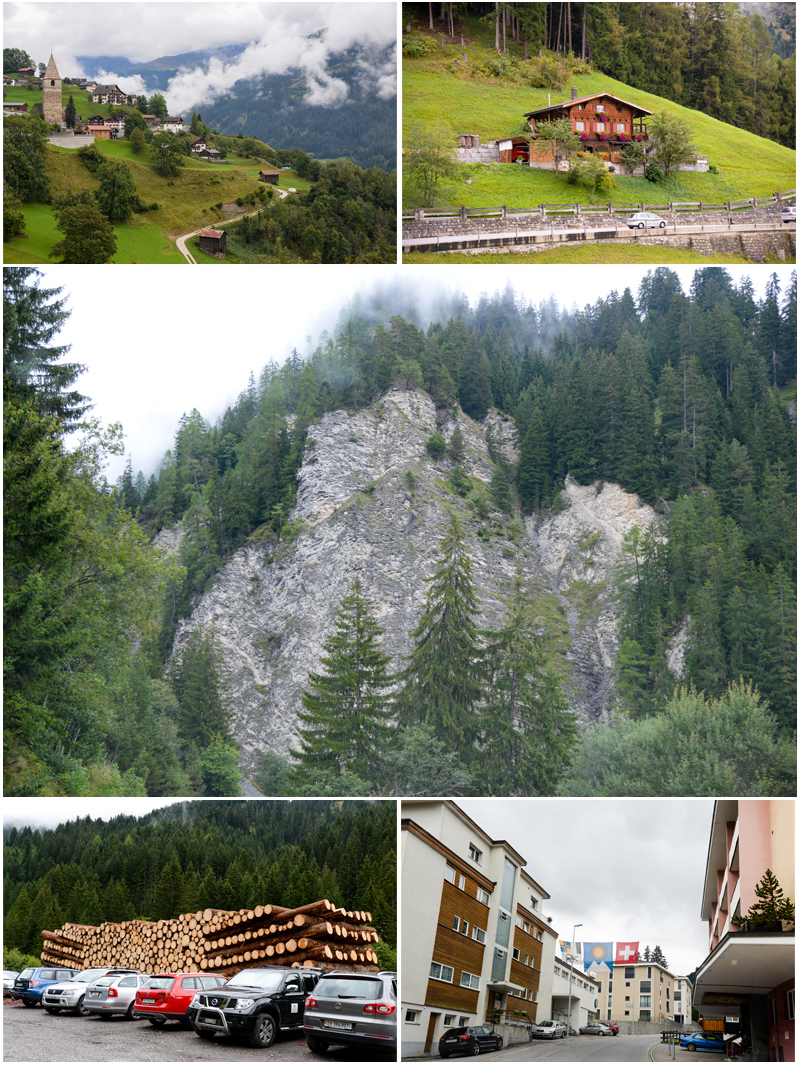 We arrive in Arosa ten minutes late. It is at this point we learn it is an unpardonable sin to be late in Switzerland. We check in to the hotel, then we head for the welcome lunch. We do not unpack. Lunch at the hotel is attended by just under a hundred guests from the Bosco Gurin community. We sort of sneak in. A few guests speak English and we chat to several others with Karin acting as interpreter.
We arrive in Arosa ten minutes late. It is at this point we learn it is an unpardonable sin to be late in Switzerland. We check in to the hotel, then we head for the welcome lunch. We do not unpack. Lunch at the hotel is attended by just under a hundred guests from the Bosco Gurin community. We sort of sneak in. A few guests speak English and we chat to several others with Karin acting as interpreter.
We are late getting out the door to go to the chair lift mid afternoon. We are told we have five minutes but it takes ten. Then we walk into town, which takes more time and as we make the chair lift entry we are the last through. The cable car is full with about thirty people waiting to ride up the mountain, and we are pressed tight against the exit as the doors close.
We head up the mountain, to view White Horn. It’s beautiful up here and the air is crisp, clean and fragrantly fresh. The views are stunning. Clouds slip across the peaks and hide portions of the landscape then, as quickly as they formed they slip away to reveal the rugged scenery’s majesty a few moments later.
 A short stop at the top and then the chair lift returns us to Arosa. Our small group, comprising friends of Karin, and some residents of Bosco Gurin come across a horse team pulling an open carriage. Our hosts secure the horse team and an impromptu tour of the village begins. It is a half hour trek. The air temperature is dropping rapidly by the time we return to the hotel, so Sandra and I figure the air temp later will be freezing. We decide to catch a taxi to the dinner tonight and arrange for it to arrive at 7:15 pm. We are told to be at the front of the hotel at 7:30 pm to walk there if walking with the group.
A short stop at the top and then the chair lift returns us to Arosa. Our small group, comprising friends of Karin, and some residents of Bosco Gurin come across a horse team pulling an open carriage. Our hosts secure the horse team and an impromptu tour of the village begins. It is a half hour trek. The air temperature is dropping rapidly by the time we return to the hotel, so Sandra and I figure the air temp later will be freezing. We decide to catch a taxi to the dinner tonight and arrange for it to arrive at 7:15 pm. We are told to be at the front of the hotel at 7:30 pm to walk there if walking with the group.
The Walsertreffen Festival Dinner is a huge Swiss internal village event. I did a rough count, forty per table by forty four tables and fourteen per table by another forty four tables. Roughly two and a half thousand people at a single dinner. Most dress in local village costume. Karin is dressed in her costume and she tells me it is an honour and privilege to wear one. There are conditions however, and not just anybody can wear one. I am told you must be a local, you must be a resident most of the time at a particular village and you need to have earned the right to wear one. They are historical, old and quite diverse costumes and we saw many different ones during the evening. There was a three course meal and drinks, and throughout the evening there was live entertainment. Walsertreffen is a celebration of tradition, Swiss culture and village life. The pride and Swiss spirit of this triannual event is huge.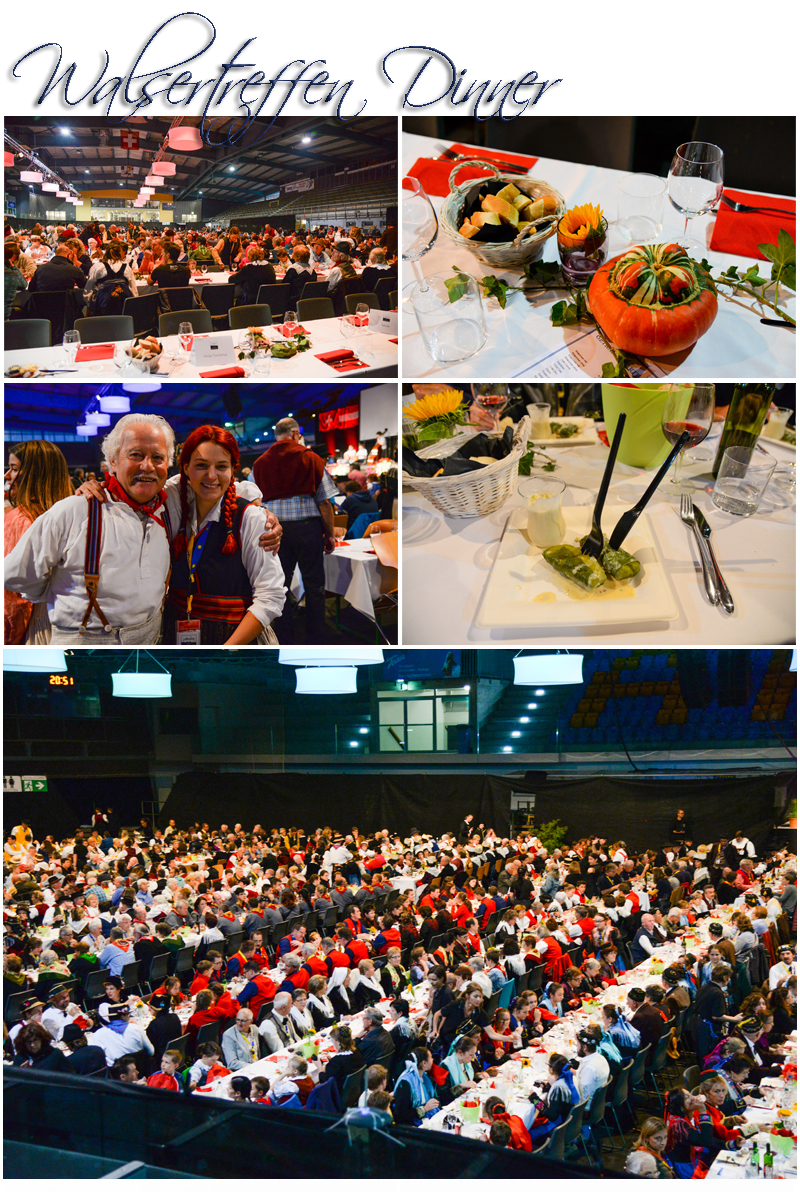
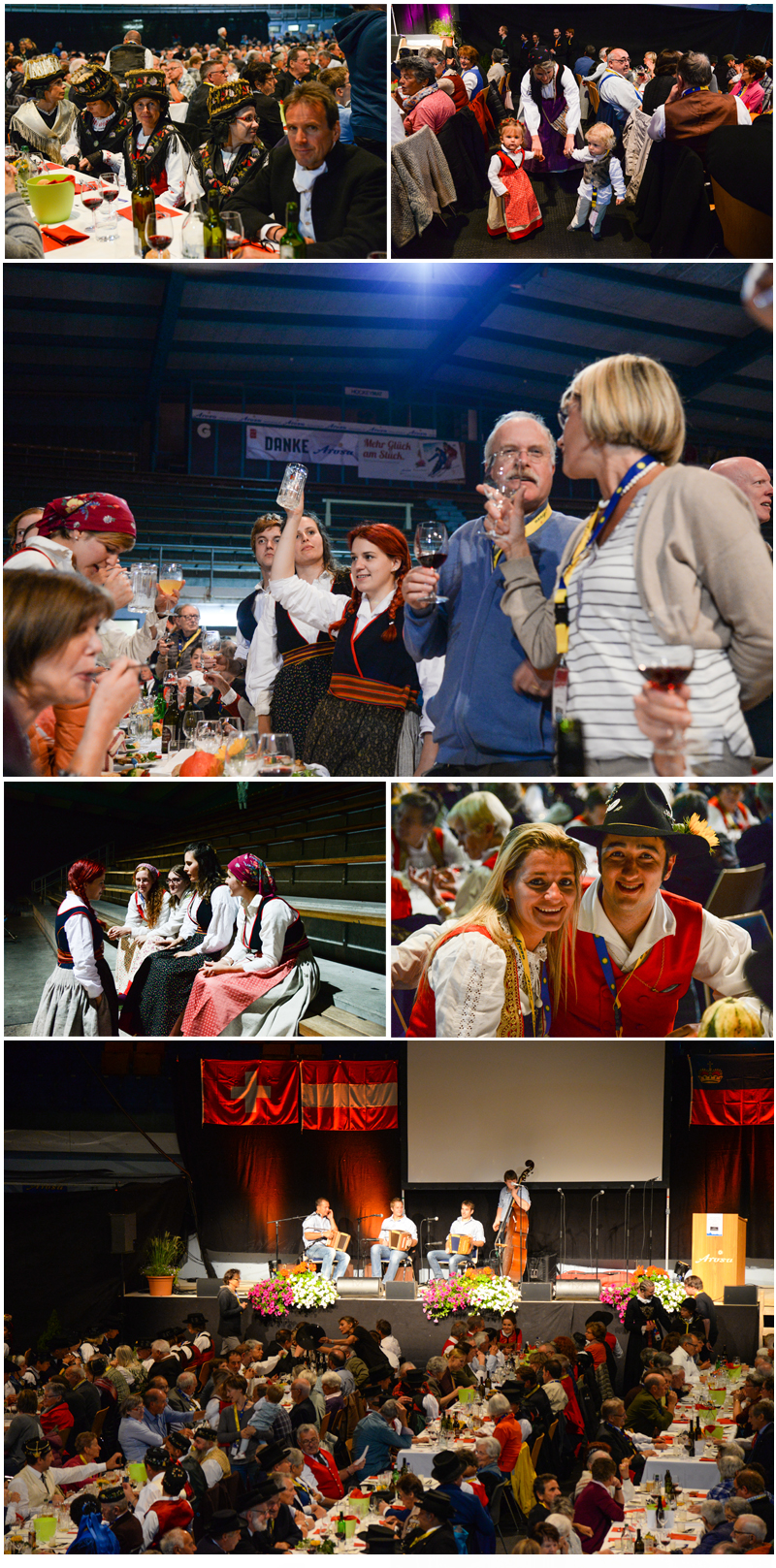 Day Four – 18th. September – Sunday – The meeting point this morning is breakfast at 8:30 am.
Day Four – 18th. September – Sunday – The meeting point this morning is breakfast at 8:30 am.
Sandra and I catch a shuttle bus to the gymnasium where church is being held this morning. The sky is a soft grey and it is lightly raining. The gymnasium holds about 500-700 worshippers and the service is in German. There’s a choir. The music is beautiful and although we don’t understand a word that is spoken, we know when to respond as a catholic service is a catholic service in any language, and amen spoken in unison sounds similar in many dialects.
The service concludes and we head outside. There’s an air of expectancy as the villagers are gathering dressed in costume ready for the street parade. At 12:30 pm the parade begins and it is a joyous occasion. There is music and dancing, bands and uniforms, decorated homemade floats, rustic costumes and farm animals, children and musical instruments. There are not many people along the sides of the roads as most are participating in the parade. I find a great vantage point with a phenomenal background, Swiss buildings either side, a mountain to the rear, and an elevated hill. The camera is kept busy.
I stop and pause however, after the parade starts. After villagers have started to make their way past me and as three gigantic Swiss horns and their players approach, stop, then boom the rich sounds of pure Switzerland through their wooden instruments in deep resinous symphony. I think to myself at that moment, I am in Switzerland. I am in the land my Great Grandfather Gasper left behind in 1858, seeing things that surely he would have known as familiar. And I feel an uncanny sense that my father, who never visited this beautiful part of the world, is watching me now and smiling. It is a poignant and very moving moment and I feel a deep joy at being able to spectate what my father never saw. I am witness to this Walsertreffen Festival that is today such an authentic snapshot of Swiss tradition and history. I am seeing humble but hardwon Swiss culture and its reluctance to give entirely way to modern times. My father loved attending “Back To” celebrations. And I know at this precise moment, without doubt, he would have loved to be with me here seeing this!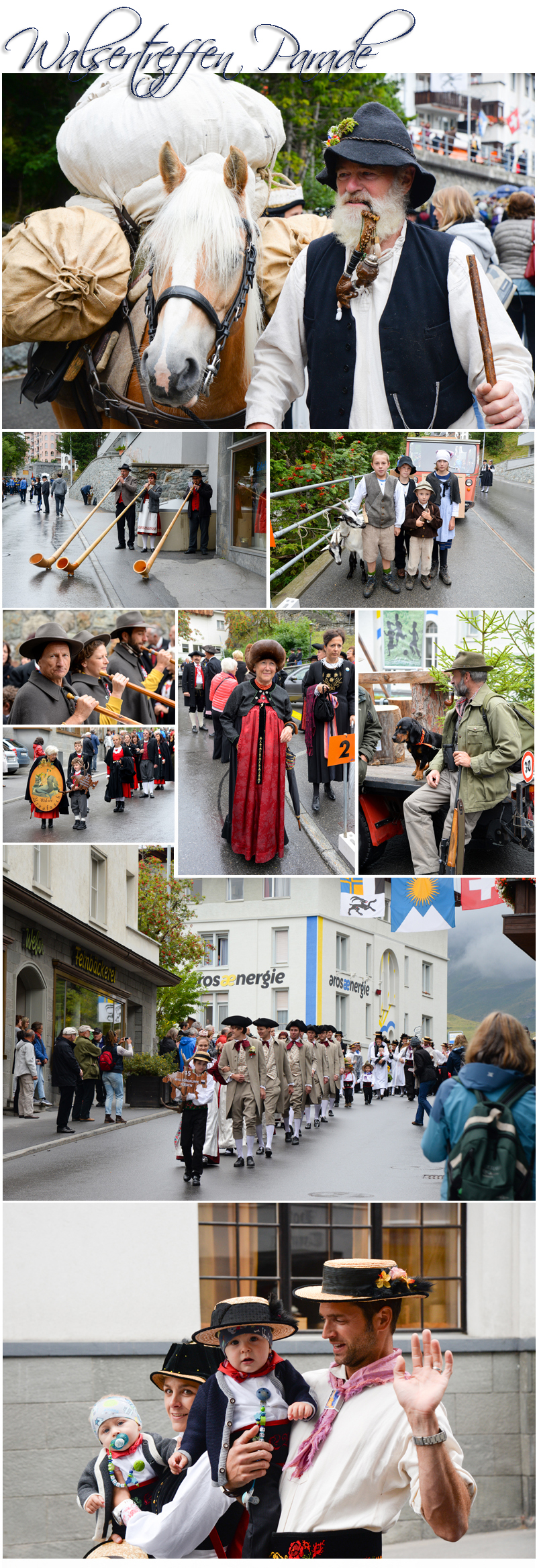
 I am kept busy photographing the fabulous sights before me then, following the crowd after the parade, I head to the stadium, where two and a half thousand people are enjoying a buffet lunch. I am amazed. The catering, once again, is flawless. Having worked in hospitality my mind spins with the planning required to pull a buffet off with these sorts of numbers.
I am kept busy photographing the fabulous sights before me then, following the crowd after the parade, I head to the stadium, where two and a half thousand people are enjoying a buffet lunch. I am amazed. The catering, once again, is flawless. Having worked in hospitality my mind spins with the planning required to pull a buffet off with these sorts of numbers.
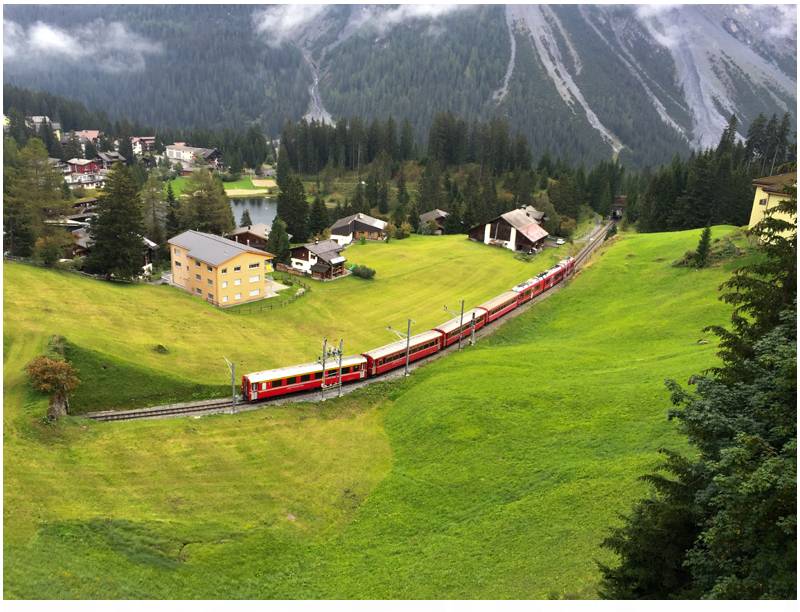 Karin, Sandra and I depart Arosa around 3:45 pm and head back to Chur. From there it’s onto Bosco Gurin via the St Bernardino Pass and Ticino. The drive is breathtaking and Karin is an excellent tour guide. We hear a lot about the region and she points out local icons and villages along the way.
Karin, Sandra and I depart Arosa around 3:45 pm and head back to Chur. From there it’s onto Bosco Gurin via the St Bernardino Pass and Ticino. The drive is breathtaking and Karin is an excellent tour guide. We hear a lot about the region and she points out local icons and villages along the way.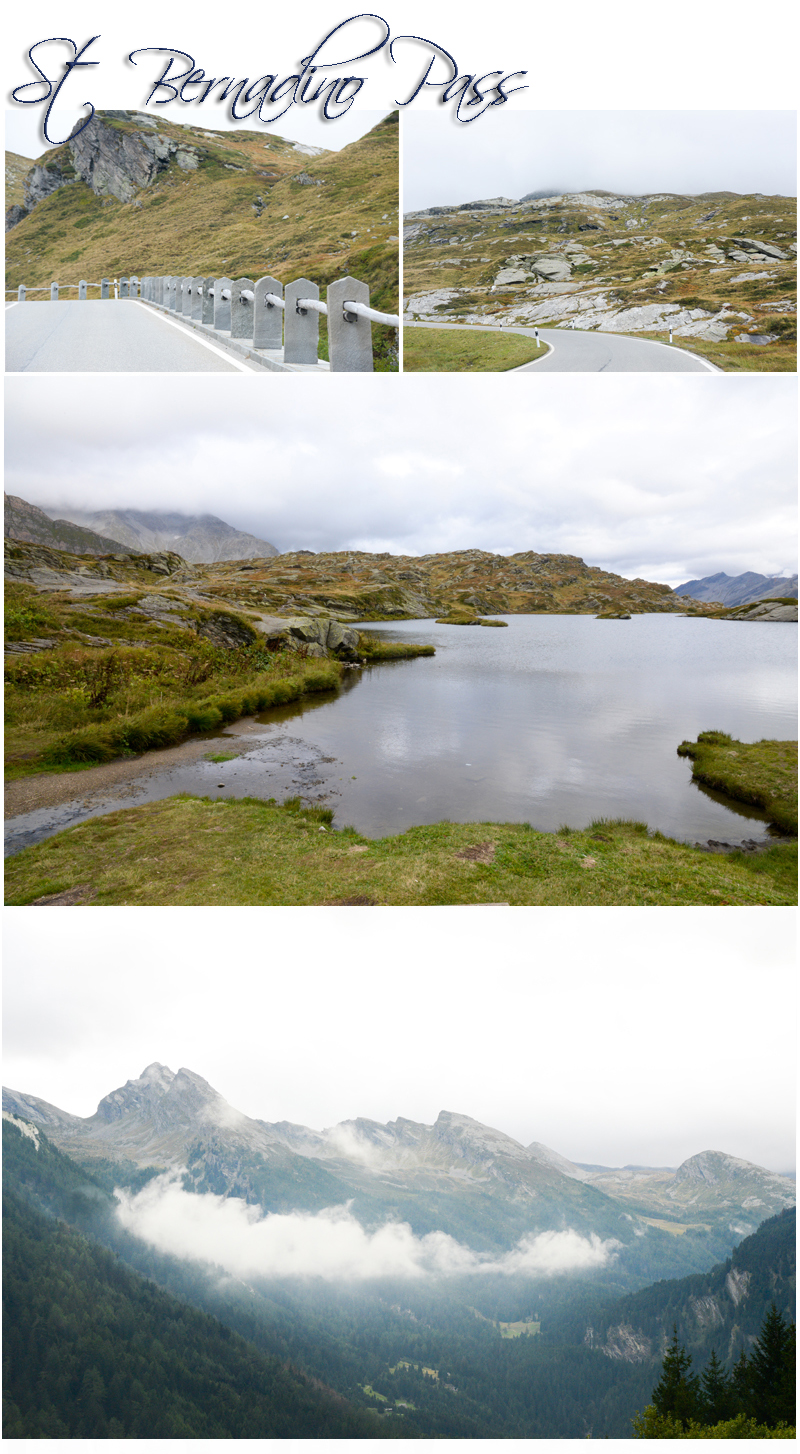
We arrive in Bosco Gurin around 8:00 pm and it is barely light enough to tour but Karin takes us around and points out our Great Grandfather Gasper’s house (the oldest house in the village), the church and graveyard, and the cattle sheds where the cattle live during winter. I take an evening shot of the town and it’s fully dark by the time we finish. Karin has arranged for a Swiss fondue for us at the local restaurant. It’s delicious but simple fare, creamy cheese and white wine and bread. Fondue with two cups of tea is 49.00 Francs. We have had a wonderful day and we crash into our beds. Touring is exhausting.
Day Five – 19th. September – Monday – Breakfast this morning was at Karin’s parent’s B & B in Bosco Gurin. We had a good night’s sleep in one of the modern rooms and were toasty warm overnight and in the chill of early Autumn high in the Swiss Alps. Having left winter in Australia behind the temperatures here seem warm to us although the locals believe it’s quite cool. And Bosco Gurin is nt as cold as Arosa tonight. We turn off the room heating upon arrival and enjoy the balmy weather overnight with the French doors open.
Today we are meeting Cornelia who is showing us our Great Grandfather’s house which is now a museum, and later she is taking us on a comprehensive tour of the village. We meet at 10:00am and I immediately realise I need to take notes as this sprightly 85 year old woman with a spring in her step, and who is still an avid skiier, has many stories to tell, so I decide to record her recitations for a book and write them up at a later date.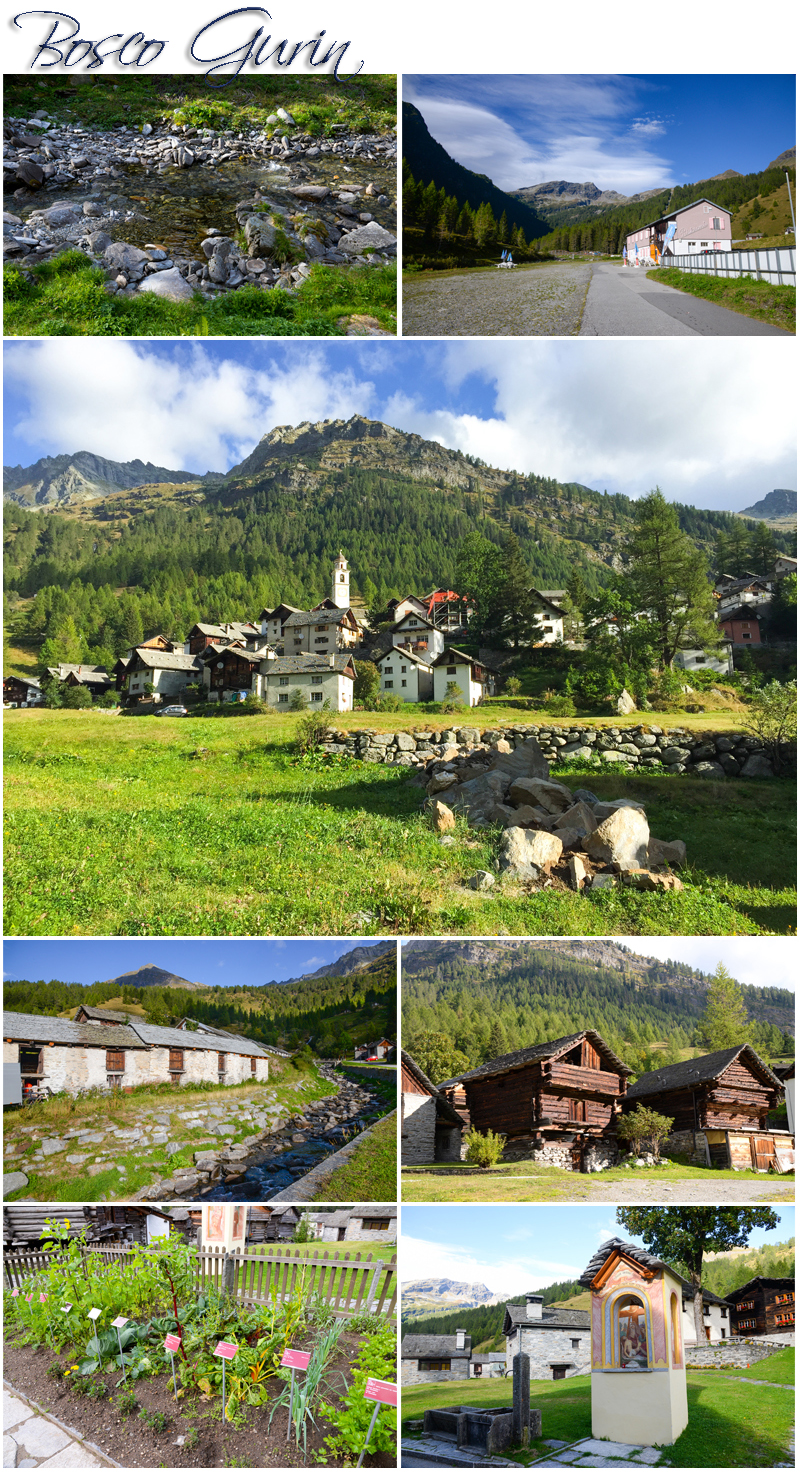 The home of my Great Grandfather Gasper Tomamichel is a museum now and we spend two hours there. It is the oldest house in the village, was built in the 1300’s, and is made of wood and stone. Michele Michael Tomamichel had three sons, Michael, Gasper and Antonio. Michael and Gasper left Bosco Gurin in 1858 to make their fortunes in Australia. The village had over 600 residents when they left, there was little work, little food, and the conditions of life in the village were harsh. Together, with fifty six other villagers, they made the trek on foot out through the alps to Cevio then they headed on to England. Some of the group sailed to Australia with Michael and Gasper, the others went to America, but the two groups would act as support groups for each other in the new lands.
The home of my Great Grandfather Gasper Tomamichel is a museum now and we spend two hours there. It is the oldest house in the village, was built in the 1300’s, and is made of wood and stone. Michele Michael Tomamichel had three sons, Michael, Gasper and Antonio. Michael and Gasper left Bosco Gurin in 1858 to make their fortunes in Australia. The village had over 600 residents when they left, there was little work, little food, and the conditions of life in the village were harsh. Together, with fifty six other villagers, they made the trek on foot out through the alps to Cevio then they headed on to England. Some of the group sailed to Australia with Michael and Gasper, the others went to America, but the two groups would act as support groups for each other in the new lands.
The family home was passed onto Antonio after Michele passed as Michael, who had left with Gasper, had died not long after he arrived in Australia and Gasper never came back to Switzerland. However, as Antonio was a priest, the house was given over to the village as priests were not to be in possession of worldly goods.
Cornelia shows us many utensils, artefacts and original tools used by the Bosco Gurin residents which were gathered some time back to put into the museum. It is fascinating to see things like a home made mouse trap, a loom used for weaving (even today), and the wood working tools housed in a glass cabinet in a room upstairs. We are told of the way the villagers stored bread, churned butter and made cheese. We see fireplaces and beds. Armoires, clothes and clothing storage trunks. And there is an indoor drop toilet. The doors we make our way through are low and the rooms tiny. Our forefathers were shorter than we are. And there is a staircase made out of a single log. I sit in a chair that was owned and used by my Great Grandfather Gasper. And nearby there are underground cattle sheds, barn storage and cellars.
It is a surreal experience standing in the original home of my relative, my Great Grandfather Gasper who undertook a life changing journey to come to Australia almost one hundred and sixty years ago. And for the duration of the time I am wandering in his former home, I feel in touch with him, connected to him. I have often asked myself why did Great Grandfather Gasper leave? Why did he say goodbye to all that was familiar, all that was home? He left to make a new start. To eek out a new existence and new lifestyle. To survive. I have always wondered not only why he would leave, but if he had ever looked back. And standing here listening to Cornelia, I believe I have my answer. He left because he had to, but Australia was good for him. He met his wife, had a large family and developed a farm of sizable acreage. He lived to an old age. But Great Grandfather Gasper would have to have left part of his heart in Bosco Gurin I find myself thinking, and I suddenly realise I have done also. For this place feels suprisingly like home. It is strangely familiar, and at this moment, it is uncannily comforting to be here.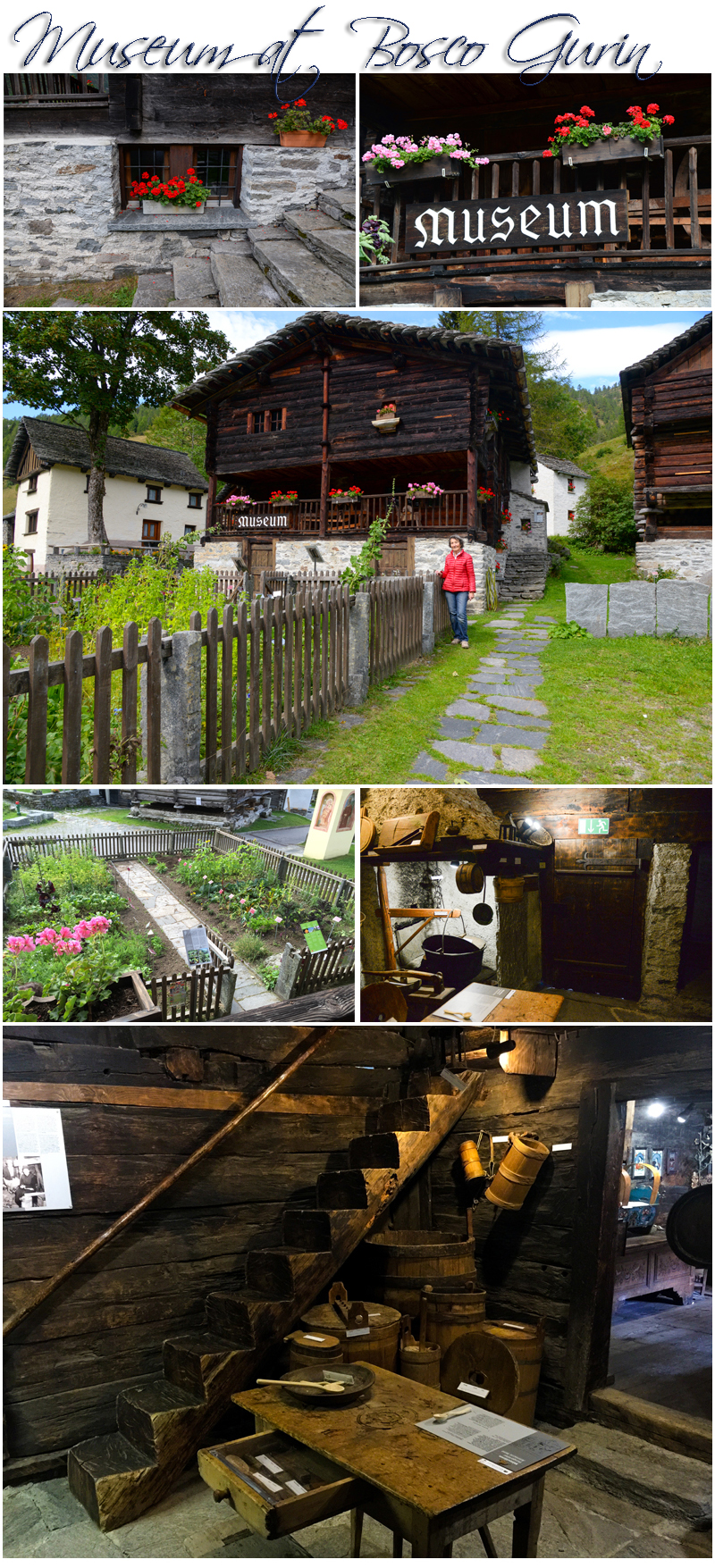
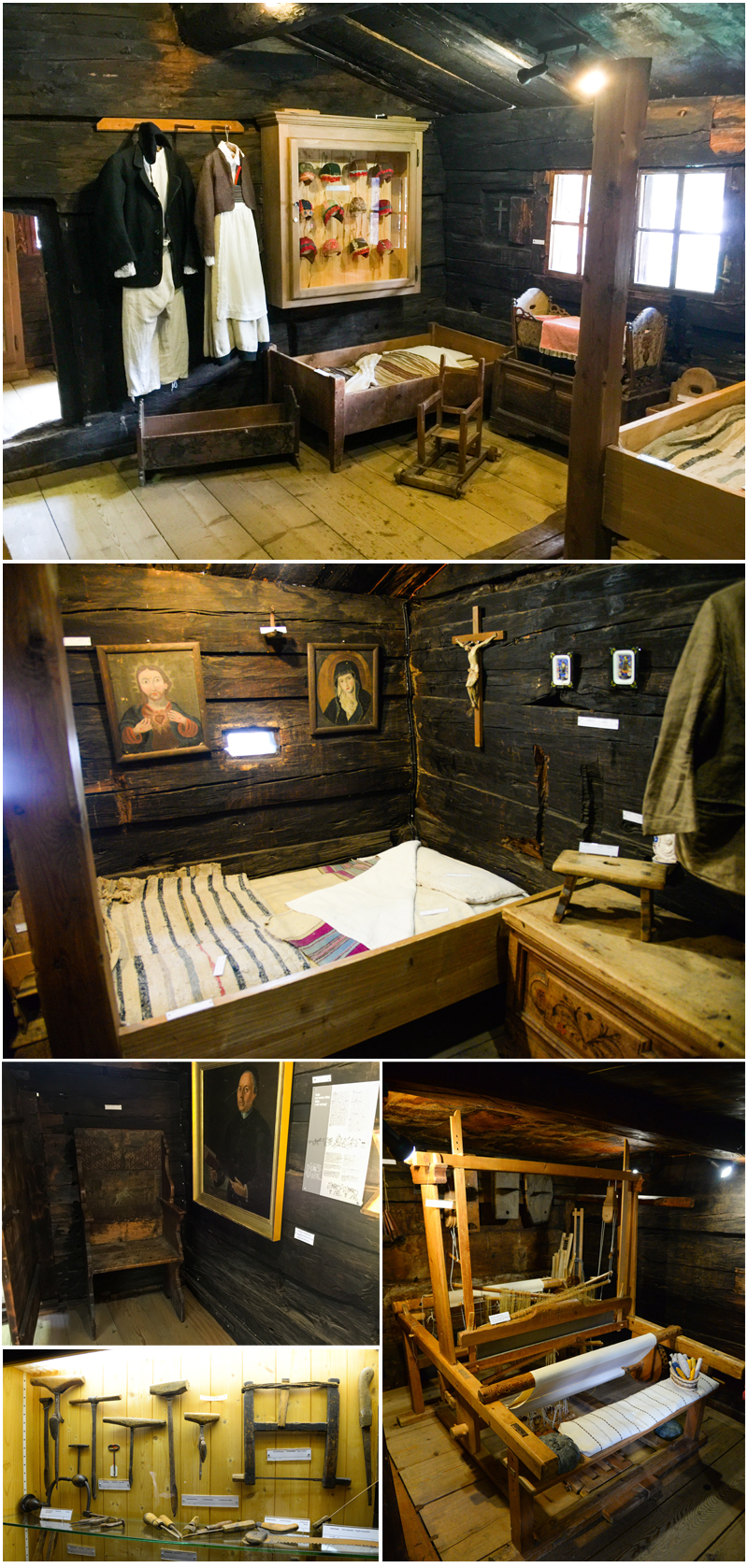 We break for a meal at Cornelia and Paolo’s house and enjoy a rustic lunch. A special soup “Mazufamm” which will be made for a festival next weekend is served to us, as we aren’t going to be there that day. It is followed by brown bread, chorizo sausage and cheese. Steamed saveloys with mustard and after, I enjoy a cup of home brewed coffee. Cornelia makes her own teas from garden flowers and we also have a unique floral variety offered to us made from ten different flowers.
We break for a meal at Cornelia and Paolo’s house and enjoy a rustic lunch. A special soup “Mazufamm” which will be made for a festival next weekend is served to us, as we aren’t going to be there that day. It is followed by brown bread, chorizo sausage and cheese. Steamed saveloys with mustard and after, I enjoy a cup of home brewed coffee. Cornelia makes her own teas from garden flowers and we also have a unique floral variety offered to us made from ten different flowers.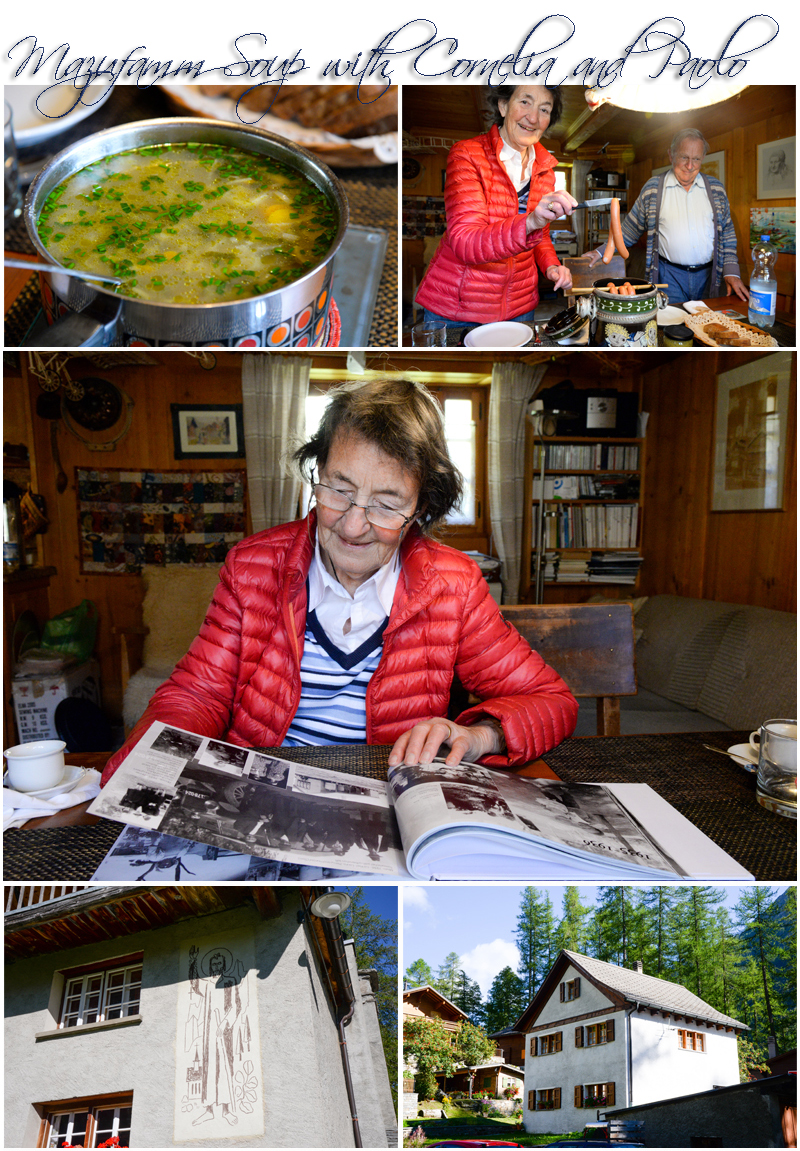 After lunch I show Cornelia the two books I have brought with me from Australia. I give her a copy of the one I made in 2009, it is about the journey of Gasper, Percy and later my father John (Jack) into farming in Australia and has several hundred photographs, all dated and the people in them identified. It is the missing piece of the jigsaw puzzle about what happened to Gasper after he left Bosco Gurin and Cornelia is thrilled as it also has two family trees in it; she is an avid historian.
After lunch I show Cornelia the two books I have brought with me from Australia. I give her a copy of the one I made in 2009, it is about the journey of Gasper, Percy and later my father John (Jack) into farming in Australia and has several hundred photographs, all dated and the people in them identified. It is the missing piece of the jigsaw puzzle about what happened to Gasper after he left Bosco Gurin and Cornelia is thrilled as it also has two family trees in it; she is an avid historian.
The other book I show Cornelia is for Karin, but I invite Cornelia to ask Karin if she can read it at a later date after Karin has had a chance to read it. Karin’s book is the first copy of my Father’s memoirs that I have written up and had printed just prior to leaving on this trip. I gave it Karin as a thank you for running us around and hosting us at the Arosa event, the Walsertreffen, and for bringing us to Bosco Gurin.
After showing Cornelia and Paolo the books, Cornelia pulls out her copy of the family tree. It is a record of my forefather’s which heralds back to 1520 so I photograph it to write up when I get home. She is pleased to share the treasure.
Cornelia’s father was a Tomamichel, but from a branch higher up the family tree so we are distant cousins. He was a renowned artist and trained for a number of years in Zurich and Paris. Cornelia has already given us a copy of a small book of his work. I photograph a number of his water colours and drawings after lunch that hang on the walls in her house.
We then start a tour of the village had head towards the stunning Bosco Gurin St. James and St. Christopher Church relocated by the residents after an avalanche. It is a beautiful building. Hand painted with frescos inside and beautifully decorated. The chapel just outside houses the remains of my great great grandparents. The graveyard attached to the church is so tiny, that the bodies laid to rest there are only left there twenty years before they are exhumed and then buried in a more shallow mass grave to further decompose for a number of years. After that they are placed under a stone in the chapel as their final resting place. So there is no plaque, just the knowledge that my forefather and foremother rest here. This was on my list of things to do, “to visit the final resting place of my Great Great Grandparents”.
 We are then taken on an informative housing and art walk, where Cornelia shows us some of her father’s work in the form of “graffito” artwork on the walls of a number of the houses and she tells us about many of the different cottages and buildings. Hans Tomamichel was a fabulous artist, lived from 1899 – 1994, and is buried in the graveyard below the church; a unique artwork marks his resting place.
We are then taken on an informative housing and art walk, where Cornelia shows us some of her father’s work in the form of “graffito” artwork on the walls of a number of the houses and she tells us about many of the different cottages and buildings. Hans Tomamichel was a fabulous artist, lived from 1899 – 1994, and is buried in the graveyard below the church; a unique artwork marks his resting place.
 It is a full, vibrant day and the village is exquisite. The original village is made up of stone buildings which are old, and we are told much of the village has been relocated over the centuries due to avalanches, to the areas where the avalanches seem to miss, and this has presented its own set of problems. Huge rocks are dotted amongst the existing dwellings, some having been to big to remove easily by hand. The gentler slopes where the debris from the avalanches rests lie vacant. Cornelia tells us it is considered too risky to build on them.
It is a full, vibrant day and the village is exquisite. The original village is made up of stone buildings which are old, and we are told much of the village has been relocated over the centuries due to avalanches, to the areas where the avalanches seem to miss, and this has presented its own set of problems. Huge rocks are dotted amongst the existing dwellings, some having been to big to remove easily by hand. The gentler slopes where the debris from the avalanches rests lie vacant. Cornelia tells us it is considered too risky to build on them.
Modern materials, and repair materials including stone for roofs is brought in by helicopter in these times, and it presently costs around 38 Francs a minute for the helicopter. The access road here, to Bosco Gurin, is steep and winding, so the location of the village makes it difficult for anything to arrive in bulk by road in anything other than the smallest truck. I am fortunate to see both a helicopter and small truck ladened with building materials today, and it brings real clarity to the remote village’s upkeep and development difficulties. The scenery is around me is stunning. There are huge alps in every direction. On the slope of a peak to my right, where the last avalanche in 1925 left the face of the mountain bare, there are now wooden and steel fences erected across the top third of the slope. And plantings of newer trees cover the slope face the rest of the way down to try to stop future avalanches occurring. The avalanche scar on the mountain to my right was the one that demolished the building only metres in front of Gasper’s home. It destroyed many dwellings. After the snow and ice melted the timber and stone from the wrecked buildings was reused to make newer dwellings in other places in the village. The area in front of Gasper’s house is now a vegetable and flower garden.
The scenery is around me is stunning. There are huge alps in every direction. On the slope of a peak to my right, where the last avalanche in 1925 left the face of the mountain bare, there are now wooden and steel fences erected across the top third of the slope. And plantings of newer trees cover the slope face the rest of the way down to try to stop future avalanches occurring. The avalanche scar on the mountain to my right was the one that demolished the building only metres in front of Gasper’s home. It destroyed many dwellings. After the snow and ice melted the timber and stone from the wrecked buildings was reused to make newer dwellings in other places in the village. The area in front of Gasper’s house is now a vegetable and flower garden.
Looking up you can see bare areas on the higher peaks where skiing is popular as this area has snow seven months of the year, and is a popular skiing destination. And there are clearly defined walking trails, so the area is also popular with hikers in the summer. There is a chairlift which runs every day in the summer and winter but only on Saturday’s during off peak periods. I see the occasional tourist walking in the village. There are no real shops here. The tiny grocery store is only open set hours and at this time of year the bakery operates only twice a week. There is an ATM only, no bank, a restaurant, a pizza shop, hotel and numerous B&B’s.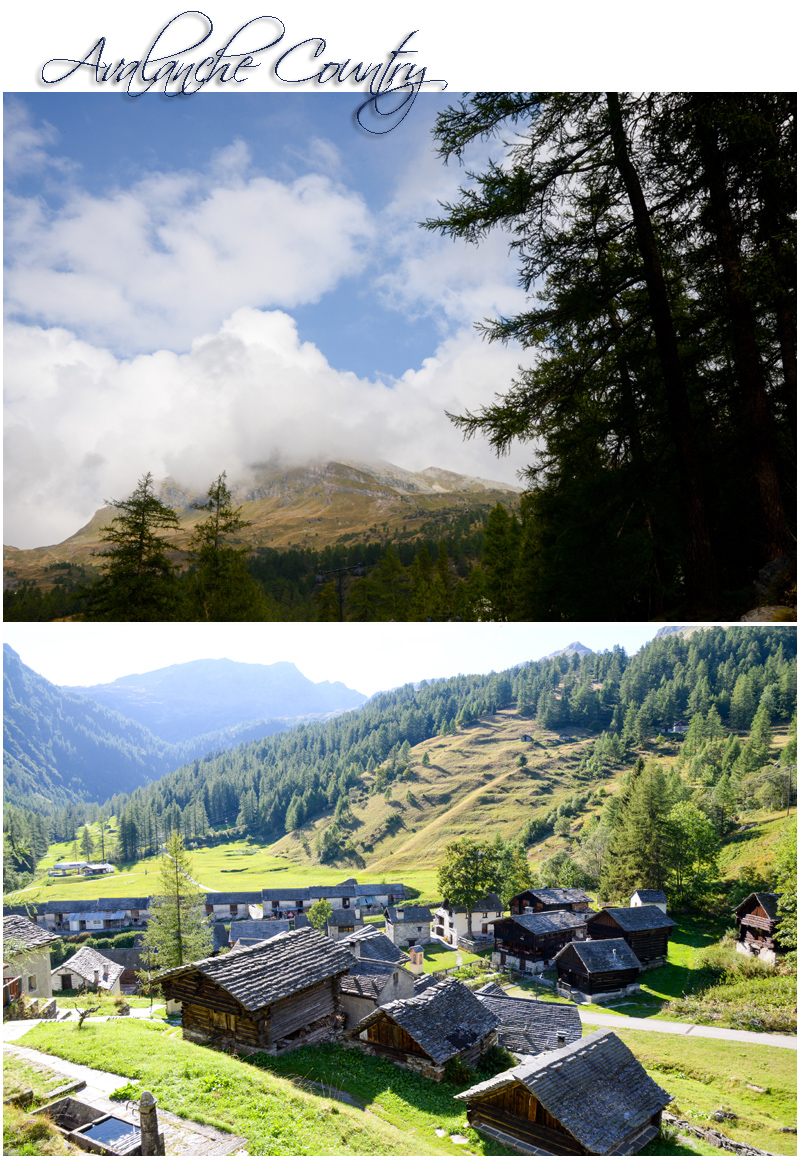 This evening we went to dinner with Lino and Elena (Karin’s parents) and Cornelia and we ate another authentic Swiss dish tonight, Rosti. It was delicious. And to our surprise, as we left, we discovered our three hosts had all shouted us dinner. It was a wonderful gesture and very much appreciated.
This evening we went to dinner with Lino and Elena (Karin’s parents) and Cornelia and we ate another authentic Swiss dish tonight, Rosti. It was delicious. And to our surprise, as we left, we discovered our three hosts had all shouted us dinner. It was a wonderful gesture and very much appreciated.
Day Six – 20th. September – Tuesday – We have decided to stay an additional day in Bosco Gurin and the room is 120 Francs, which is not expensive. I wake to the smell of wood smoke in mountain air. The river flows past at the base of our accommodation and the water rushing over the rocks, as it runs downhill, has a calming effect; its sound is restorative to the soul. Today is a day of rest. There’s time to catch up on my journals, emails and sleep.
Later I wander down to the beautiful handmade wooden bridge that crosses the river at the lowest part of the town. I am lured by the chiming and ringing of cow bells. The sound is like a huge wind chime, dozens of bells all shapes and sizes peeling out their own unique sounds. The cows are grazing at the bridge’s entrance. There are about twenty cows. I walk across the bridge and am able to pet the animals. They are tame and used to human interaction. They are lovely beasts, solid, thick and well built with a lot of condition on their sturdy frames. They are a breed well suited to cold temperatures. Their coats are a range of brown beige colours, and thick hair blankets their hides.
Each cow has a large bell attached to a thick leather collar. The bells are all shapes and sizes. I see one that is the usual bell shape but most are square or flatter and curved in shape. The various bells are different sizes and thicknesses, and the swinging striker underneath is also of different lengths, shapes and thicknesses. Each bell its own individual sound and up close it is very noisy. The cows are deaf because of the noise but the bells are necessary as the cows graze open range and are more easily found if lost in bad weather. They are housed in stone sheds at night, and before winter sets in in earnest, they are put into closed sheds out of the snow for the duration.
Some cow sheds are underground and some are above ground. The underground ones have wooden barns on top with a gap in between the cattle shed and barn of about a metre where wood and other items are easily reached and stored out of the weather. There are mushroom shaped stones between each pillar that holds the barn on top and the cow shed, these stop mice getting into the barn storage. They are beautiful practical structures.The houses have stone bases and wooden or stone tops and most are hundreds of years old. They are all at least two stories, some are three and all have an underground cellar. The roofs are stone. There are either low pitched or high pitched roofs. The low pitched roofs allow the snow to settle and it gives the house added insulation. The high pitched roofs allows the snow to drop off before it gets too heavy. I saw a film yesterday at the museum where the snow was several metres high on the houses’ roofs and there were channels cut for walking in the snow in between them, about a metre and a half wide. Snow covered everything else in sight and was over two to three metres high on the ground.
Each house has flower boxes at the moment filled with bright red, yellow, pink, white or purple flowers. In the winter the flower boxes are brought inside. There are also small vegetable gardens outside each house. Land is at a premium and the houses are small, gardens even smaller. The productive land, where potatoes and other vegetables are grown is further up the hill, and in the film I saw, dated in the 1970’s, it showed the traditional baskets used to transport everything from potatoes, wood, stones or whatever is needed from the hillsides to the village below. The community does not use wheelbarrows on the higher slopes although I have seen one four wheel motor bike and a small tractor and wagon. The people that still use and carry these baskets are very fit. Farming today however, is apparently somewhat different to farming in the past.

 The church bells ring at set times every day, and the Swiss are genuine time keepers. The bells peel at 6:00 am, 12:00 pm, and 7:30 pm, they also peel in times of emergency like an avalanche and the death of a resident. The church is significant within this community and everybody goes to church. It is a striking building, simple on the outside yet commanding in stature, and beautifully ornate inside. There is a pipe organ at the rear and there are hand painted frescos on the roof and several pillars inside. The chairs are made as wooden pews but look more like rough sawn benches and when you sit in them there’s a kneeling bench attached so you are semi sitting and kneeling at the same time.
The church bells ring at set times every day, and the Swiss are genuine time keepers. The bells peel at 6:00 am, 12:00 pm, and 7:30 pm, they also peel in times of emergency like an avalanche and the death of a resident. The church is significant within this community and everybody goes to church. It is a striking building, simple on the outside yet commanding in stature, and beautifully ornate inside. There is a pipe organ at the rear and there are hand painted frescos on the roof and several pillars inside. The chairs are made as wooden pews but look more like rough sawn benches and when you sit in them there’s a kneeling bench attached so you are semi sitting and kneeling at the same time.
I visit my Great Grandfather Gasper’s house again, the cow sheds and the adjoining area where the avalanche flattened the original older part of the village. I also see a friend whom I met at Arosa having wine with his wife and neighbours. They ask if I’d like to stay too, but I want to do a last lap of the town. A last tour. I visit the shop, and the hotel. Then I make my way to the hotel I have a couple of excellent red wines and a quiet reflective dinner on my own.
An early night for me tonight as Sandra and I are headed to Milano tomorrow on the bus then train.
Day Seven – 21st. September – Wednesday – We are up early but have a lazy breakfast at the B&B as we are leaving Bosco Gurin today. Sandra spent some time with our hosts last night and I believe they may visit us in the future. Elena tells us she will take us and our bags to the bus but to call first at the Museum, Great Grandfather Gasper’s house, at 10:00 am this morning. She reads this from a slip of paper written in Italian, or English, I do not know which, as she only speaks Italian, but we do a fair job of understanding each other using our own style of sign language when our words aren’t making sense. The meeting is so that Sandra can see the film on Bosco Gurin that I saw yesterday.
Our bags are loaded and we head to the museum where we are also given souvenirs, the Tomamichel emblem on a piece of wood depicting our branch of the family, stickers with Bosco Gurin on them, a key ring and so on. Cornelia gave us several souvenirs the day before yesterday and a small book each so we are leaving with quite a selection of memorabilia. A last look at the village with Elena then she takes us to the bus stop. There is a bus running from this point several times a day and we depart at 11:05 am precisely. The Swiss are fastidious about time keeping. The bus driver throws our bags in the luggage compartment. “Hey hey hey.” We both call out “be careful” he just replies “no grazia” in other words “we” hadn’t even said thanks. But it was the first bag to be loaded, the thanks usually come after in Australia so we thought he was being premature. I figure this guy really needs to lighten up. So we wait for our moment on the trek down the mountain and on a particularly tight bend we both clap and call out “bravo bravo” indicating we appreciate his outstanding driving skills. He is flattered. He has melted a little from the chilly front we have been experiencing thus far. The drive down the mountain is incredibly scenic. Bosco Gurin is high in the alps and the road twists and turns tightly all the way to the valley below. There is evidence lower down of fires having burnt there however, no evidence higher up. It is new to us seeing this area as when we arrived it had been too dark to see much of this part of the journey at all.
A last look at the village with Elena then she takes us to the bus stop. There is a bus running from this point several times a day and we depart at 11:05 am precisely. The Swiss are fastidious about time keeping. The bus driver throws our bags in the luggage compartment. “Hey hey hey.” We both call out “be careful” he just replies “no grazia” in other words “we” hadn’t even said thanks. But it was the first bag to be loaded, the thanks usually come after in Australia so we thought he was being premature. I figure this guy really needs to lighten up. So we wait for our moment on the trek down the mountain and on a particularly tight bend we both clap and call out “bravo bravo” indicating we appreciate his outstanding driving skills. He is flattered. He has melted a little from the chilly front we have been experiencing thus far. The drive down the mountain is incredibly scenic. Bosco Gurin is high in the alps and the road twists and turns tightly all the way to the valley below. There is evidence lower down of fires having burnt there however, no evidence higher up. It is new to us seeing this area as when we arrived it had been too dark to see much of this part of the journey at all.
We make it to Cevio then change buses to Locarno. From there we head to the train station. We are bound for Milan then the Cinque Terra for the next leg of our trip. I am sad to be saying goodbye to Switzerland. But I fervently hope, that one day, I may return to Bosco Gurin.
Please go to https://www.travelessae.com.au/part-two-exploring-the-cinque-terra-italy to read about my journey through Italy.
